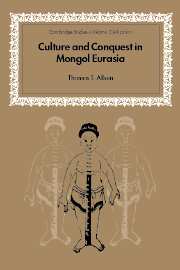Book contents
- Frontmatter
- Contents
- Preface
- Note on transliteration
- Abbreviations
- PART I BACKGROUND
- PART II POLITICAL–ECONOMIC RELATIONS
- 3 Formation of the Il-qans, 1251–1265
- 4 Grand Qans and Il-qans, 1265–1295
- 5 Continuity and change under Ghazan, 1295–1304
- 6 Sulṭāns and Grand Qans, 1304–1335
- 7 Economic ties
- 8 Overview of the relationship
- PART III INTERMEDIARIES
- PART IV CULTURAL EXCHANGE
- PART V ANALYSIS AND CONCLUSIONS
- Bibliography
- Index
- Other titles in the series
5 - Continuity and change under Ghazan, 1295–1304
Published online by Cambridge University Press: 04 September 2009
- Frontmatter
- Contents
- Preface
- Note on transliteration
- Abbreviations
- PART I BACKGROUND
- PART II POLITICAL–ECONOMIC RELATIONS
- 3 Formation of the Il-qans, 1251–1265
- 4 Grand Qans and Il-qans, 1265–1295
- 5 Continuity and change under Ghazan, 1295–1304
- 6 Sulṭāns and Grand Qans, 1304–1335
- 7 Economic ties
- 8 Overview of the relationship
- PART III INTERMEDIARIES
- PART IV CULTURAL EXCHANGE
- PART V ANALYSIS AND CONCLUSIONS
- Bibliography
- Index
- Other titles in the series
Summary
In late 1294, Baidu, one of the unsuccessful claimants of the throne in 1291, launched a rebellion against Geikhatu which ended in the latter's death early the next year. During Baidu's six months on the throne chaos reigned in Iran; the incessant plots and counterplots led to fragmentation and the near collapse of the Hülegüid state into civil war. Like his deceased rival, Baidu struck his limited coin stock in the name of the Grand Qan but deleted the title il-qan. Because of the extreme brevity of his reign, he hardly had time, whatever his inclination, to solicit, much less secure, a patent from the newly enthroned Grand Qan, Temür (r. 1294–1307), Qubilai's son and successor. Not surprisingly, the Yuan dynastic history does not mention Baidu among the Mongolian rulers of Iran.
Ghazan (r. 1295–1304) led the opposition to Baidu's faltering regime. Although the governor of Khurāsān and the designated heir apparent of his father, Arghun, Ghazan had stepped aside for Geikhatu in 1291. Now he moved energetically to claim his delayed but rightful inheritance. In the course of the struggle against Baidu, Ghazan converted to Islam in mid-June 1295. He did so, according to a recent study, because a sizable and influential group among the Mongolian army and elite in Iran had already become Muslims. Whatever his reason, once he had defeated his rival and ascended the throne in November 1295, he moved quickly to establish his credentials as a Muslim ruler.
- Type
- Chapter
- Information
- Culture and Conquest in Mongol Eurasia , pp. 31 - 34Publisher: Cambridge University PressPrint publication year: 2001



